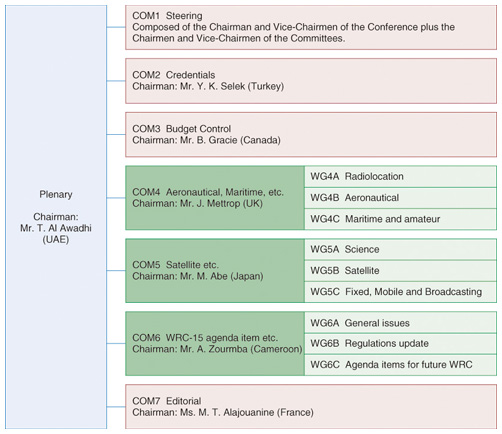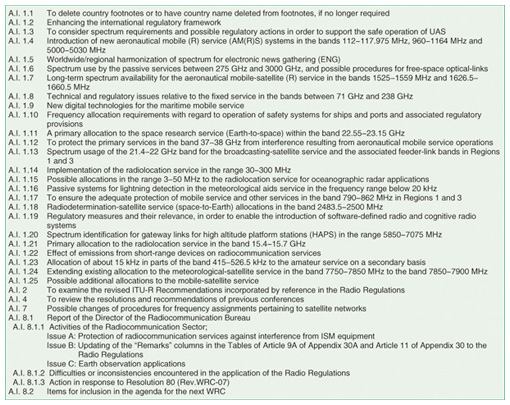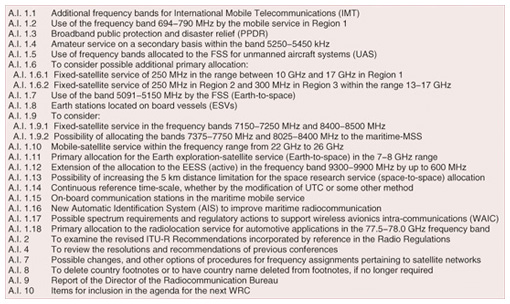 |
|||||||||
|
|
|||||||||
|
Global Standardization Activities Vol. 10, No. 12, pp. 75–82, Dec. 2012. https://doi.org/10.53829/ntr201212gls Report on ITU Radiocommunication Assembly 2012 and ITU World Radiocommunication Conference 2012AbstractThis report summarizes the activities and outcomes of the Radiocommunication Assembly 2012 (RA-12) and World Radiocommunication Conference 2012 (WRC-12), which were held from January to February 2012 in Geneva, Switzerland. RA and WRC are the major conferences of ITU-R (International Telecommunication Union, Radiocommunication Sector). 1. Radiocommunication Assembly 2012The Radiocommunication Assembly (RA) convenes before the World Radiocommunication Conference (WRC) to approve draft Recommendations prepared by Study Groups (SGs) of ITU-R (International Telecommunication Union, Radiocommunication Sector), to review and approve draft ITU-R Resolutions which describe the working methods and processes of the SGs, to evaluate the activities of the SGs, and to approve the Questions and structure of the SGs including the appointment of SG Chairmen and Vice-Chairmen for the next study period. RA-12 [1], [2] was held on January 16–20, 2012, at the Centre International de Conférences Genève (CICG) in Switzerland. 526 participants attended the conference from 102 Member States. There were 28 Japanese delegates, of which eight were from NTT and NTT DOCOMO. The structure of RA-12 is shown in Fig. 1. Under the Plenary, which manages the coordination over the entire conference activities, five committees, COM1 to COM5, were established. Among these committees, COM4 and COM5 handled the items related to the procedures and processes of the SG activities.
1.1 Approval of draft RecommendationsRA-12 considered the draft Recommendations prepared by the SGs. Four (three new and one revised) draft Recommendations were approved, while one was referred back to the SG for reconsideration. One of the new Recommendations was ITU-R M.2012, which defines detailed specifications for IMT-Advanced radio interfaces (IMT: International Mobile Telecommunications). Two radio interfaces, LTE-Advanced based on 3GPP and WirelessMAN-Advanced based on IEEE, were included in the Recommendation (LTE: Long Term Evolution, 3GPP: 3rd Generation Partnership Project, MAN: metropolitan area network). The objective of the draft revised Recommendation that was not approved was to cease adjustment of UTC (coordinated universal time) with a leap second. Three main opinions were expressed: to support the revision (USA, Japan, and some others), to oppose the revision (UK, China, and some others), and to require more information before forming an opinion (Arab and African countries). It was difficult to reach a consensus. RA-12 decided to request further study by SG7 and to propose that the issue be discussed at WRC-12 as an agenda item for a future WRC. 1.2 Approval of ITU-R ResolutionsRA-12 reviewed ITU-R Resolutions defining various matters concerning ITU-R activities. It approved 32 (6 new and 26 revised) ITU-R Resolutions and suppressed one. New Resolutions include a study on the technical requirements for utilizing cognitive radios, a study on reducing the energy consumption of wireless communication systems to reduce greenhouse gas emissions, a study on the spectrum usage of electronic news gathering (ENG) systems for global/regional harmonization, and agreement for academic organizations to participate in ITU-R activities. Revised Resolutions describe working procedures and methods applied for SG activities; clarifying the provisions for approval of ITU-R Recommendations that are not based on Questions; facilitation of the procedure for simultaneous adoption and approval (PSAA) without the two-stage correspondence process and reduction of the voting period from 3 months to 2 months; and guidelines for electing SG Vice-Chairman to balance the distribution between region, gender, and expertise, for facilitating participation by developing countries, and for determining the total number of Vice-Chairmen taking account of the SG workload. 1.3 Approval of QuestionsRA-12 approved 223 Questions including a study on technologies and performance of radio communication systems for the smart grid system and assessment of the impact on the existing systems, future trends in millimeter-wave fixed radio systems, and investigation of super-high-vision systems. 1.4 Appointment of the Chairman and Vice-Chairmen of each SGThe structure of the SGs in the previous study period was maintained (Fig. 2). The Chairman and Vice-Chairmen of each SG were elected. Dr. Akira Hashimoto (NTT DOCOMO), Noriyuki Kawai (KDDI), and Yukihiro Nishida (NHK) were elected as Chairman of SG5, Vice-Chairman of SG4, and Vice-Chairman of SG6, respectively.
2. World Radiocommunication Conference 2012WRC is the largest ITU-R international conference. It is normally held every three or four years to update the Radio Regulations (RR). The RR provide international rules and regulations for spectrum allocation to radio services, use of satellite orbits, and administrative and operational procedures for radio stations, all of which are needed for the use of radio waves. WRC-12, which was preceded by RA-12, was held for a period of four weeks from 23 January to 17 February 2012 at the same venue as RA-12 [3], [4]. Approximately 3000 participants from 160 Member States attended (Fig. 3); there were 71 delegates from Japan in WRC-12, among which eight were from the NTT Group (NTT and NTT DOCOMO).
The structure of WRC-12 is shown in Fig. 4. Under the Plenary, there were seven Committees: the Steering Committee, Credentials Committee, Budget Control Committee, Editorial Committee, and three Committees for specific agenda items. The WRC-12 agenda items are shown in Fig. 5 and some of them are discussed below.
2.1 Worldwide/regional harmonization of spectrum for electronic news gathering (ENG) (A.I. 1.5)This agenda item was intended to identify a common frequency for electronic news gathering (ENG). The conclusion, reached after enthusiastic discussion that resulted in no frequency being identified for ENG, was that it is possible to avoid the impact on existing broadcasting and telecommunications services in Japan. Since ITU-R Resolution 59 was adopted to promote the development of the database summarizing the frequencies available for ENG in each country, a WRC Resolution on the frequency database of existing services was not adopted. 2.2 Long-term spectrum availability for the aeronautical mobile-satellite (R) service in the bands 1525–1559 MHz and 1626.5–1660.5 MHz (A.I. 1.7)Procedures such as frequency coordination meetings were considered because of increasing demand for aircraft communications. Japan sought flexibility in frequency coordination for Multi-functional Transport Satellite (MTSAT). As a result, methods for objectively determining spectrum requirements were adopted, and it was specified that there would be a call for a meeting of the notifying administrations to review the issues if unsatisfactory points were found in the coordination result. Thus, a new frequency coordination procedure was implemented toward the new spectrum that Japan required. 2.3 Technical and regulatory issues related to the fixed service in the bands between 71 GHz and 238 GHz (A.I. 1.8)Sharing conditions between fixed service (FS) and passive services such as radio astronomy and the Earth Exploration-Satellite Service (EESS) in the bands between 71 GHz and 238 GHz were considered. There were two conflicting positions—no change to the current RR to promote studies on fixed wireless system (FWS) or the introduction of a mandatory spectrum emission mask to protect passive service—and a compromise was sought. The final agreement was to introduce recommended values for the spectrum mask with revision of Resolution 750. As the footnote concerning mask implementation allows administrations to continue to use their existing spectrum mask, no modifications to Japan’s regulation are needed. Moreover, study activities at ITU-R have been reinforced because Resolutions 731 and 732, which were the basis of the sharing study, were retained with some revisions. 2.4 A primary allocation to the space research service (Earth-to-space) within the band 22.55–23.15 GHz (A.I. 1.11)New frequency allocation to the space research service (SRS) (Earth-to-space), e.g., SELENE2, was considered under this agenda item. Japan has some existing systems offering FS in the band being considered, such as entrance links to mobile base stations and subscriber radio. Spectrum at 22.55–23.15 GHz was newly allocated to SRS (Earth-to-space), which is in line with the Japanese proposal. The operation and development of FS in the band 22.55–23.15 GHz is not constrained because of the very limited number of SRS earth stations in the world and because their locations should be sufficiently far from international borders in accordance with the restriction specified in the relevant footnote. 2.5 Possible allocations in the range 3–50 MHz to the radiolocation service for oceanographic radar applications (A.I. 1.15)This item treats a proposal to allocate spectrum to oceanographic radars performing sea surface monitoring for wave heights, ocean currents, and large objects’ tracks. The need for data to mitigate the effects of disasters, including tsunamis, to observe climate change, and to ensure safe maritime travel led to consideration of a new spectrum allocation for operational use by oceanographic radar networks. Eight frequency bands were newly allocated to the radiolocation service, including the band (24,450–24,600 kHz) proposed by Japan. 2.6 Regulatory measures and their relevance, in order to enable the introduction of software-defined radio and cognitive radio systems (A.I. 1.19)It was considered whether RR revisions were needed to enable the introduction of software-defined radio (SDR) and cognitive radio (CR) systems, and the conclusion was that no changes were needed. Regarding CR, the RCC (Regional Commonwealth in the Field of Communications) insisted that new WRC Resolutions be produced, while APT (Asia Pacific Telecommunity), CITEL (Inter-American Telecommunication Commission), CEPT (European Conference of Postal and Telecommunications Administrations) were of the view that no such Resolution was needed. Finally, Resolution 956 was suppressed, and a new WRC Recommendation was approved. 2.7 Spectrum identification for gateway links for high altitude platform stations (HAPS) (A.I. 1.20)Spectrum identification for gateway links for high altitude platform stations (HAPS) in the range 5850–7075 MHz was considered. Two bands, 6440–6520 MHz and 6560–6640 MHz, were identified for the HAPS gateway links in Australia and four African countries for national use. Requisites are to satisfy sharing conditions described in the ITU-R Report to protect existing services and to gain explicit consent from administrations possibly affected by the HAPS gateway links before operation commences. Although Japan has its FWS in the band being considered, there will be no problem if sharing conditions are satisfied. 2.8 Possible additional allocations to the mobile-satellite service (A.I. 1.25)New spectrum allocation to the mobile-satellite service (MSS) from several candidate bands was considered. Japan tried to avoid allocation to MSS of the nationally allocated bands used for broadcasting and telecommunication services. There was no allocation to MSS under this agenda item, but a new agenda item for WRC-15, to consider a new allocation to MSS in the range 22–26 GHz, was approved. 2.9 Items for inclusion in the agenda for the next WRC (A.I. 8.2)The agenda items for the next WRC in 2015 (WRC-15) are shown in Fig. 6. Among them, the following items were proposed by Japan. - to consider additional spectrum allocations to the mobile service on a primary basis and identification of additional frequency bands for IMT (International Mobile Telecommunications) and related regulatory provisions, to facilitate the development of terrestrial mobile broadband applications - to consider possible additional primary allocations to the fixed-satellite service (FSS) (Earth-to-space) of 250 MHz in Region 2 and 300 MHz in Region 3 within the range 13–17 GHz - to consider a primary allocation to the radiolocation service for automotive applications in the 77.5–78.0 GHz frequency band In addition, the following agenda items were proposed by other regional organizations or produced from the discussions at RA-12 or WRC-12. - to examine the results of ITU-R studies on the use of the frequency band 694–790 MHz by the mobile (except aeronautical mobile) service in Region 1 and take the appropriate measures - to consider the use of frequency bands allocated to the FSS not subject to Appendices 30, 30A and 30B for the control and non-payload communications of unmanned aircraft systems in non-segregated airspaces - to consider the feasibility of achieving a continuous reference time-scale, whether by the modification of UTC or some other method
3. Future activitiesMost of the revised RR signed by administrations at WRC-12 (Fig. 7) will take effect internationally from January 2013. In line with this, Japanese laws and regulations will also be updated and revised in 2012.
As the agenda items for WRC-15 include spectrum allocations to specific systems such as IMT and FSS, it should draw worldwide attention to these matters. The NTT Group will continue to make contributions to the ITU-R and APG (APT Conference Preparatory Group) meetings toward WRC-15. References
|
|||||||||








